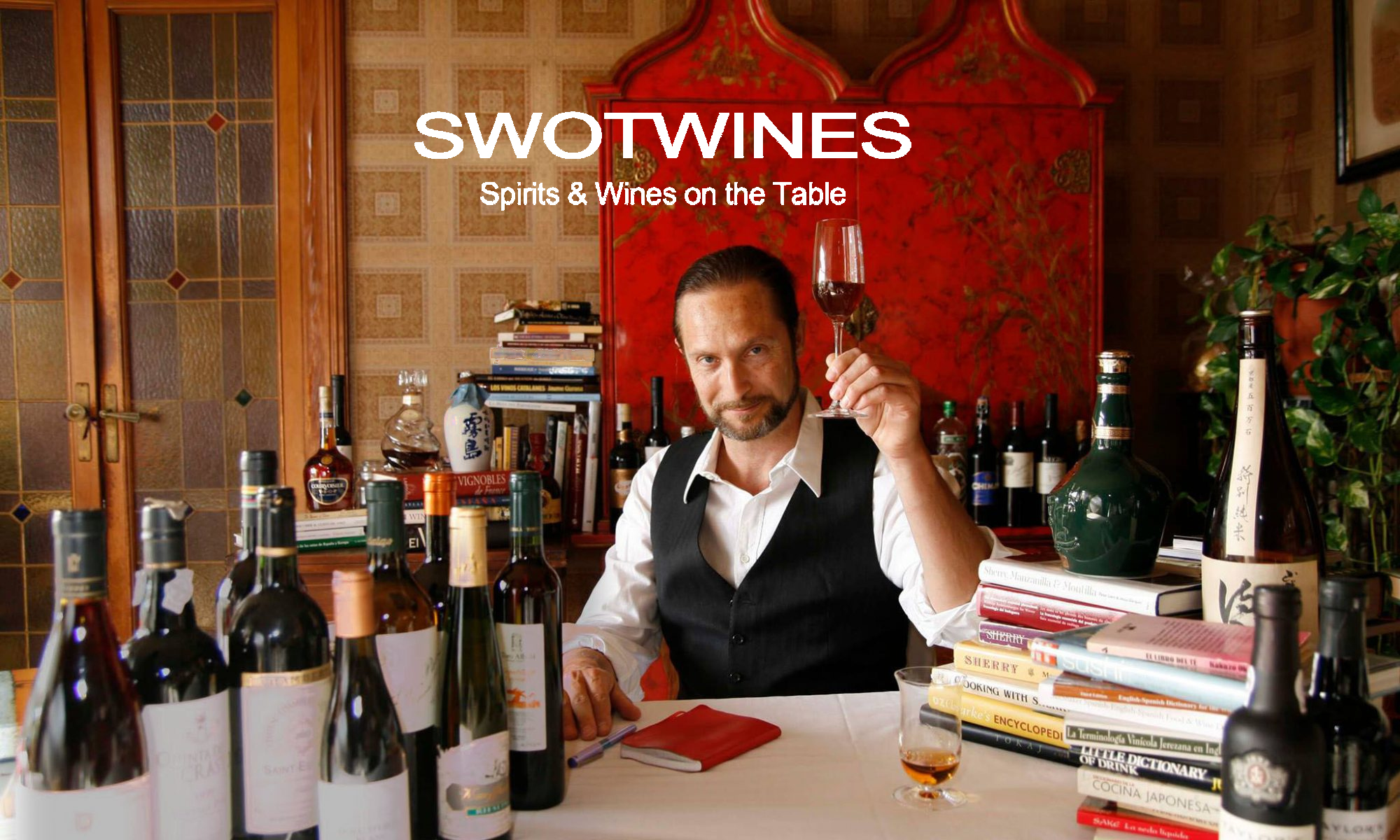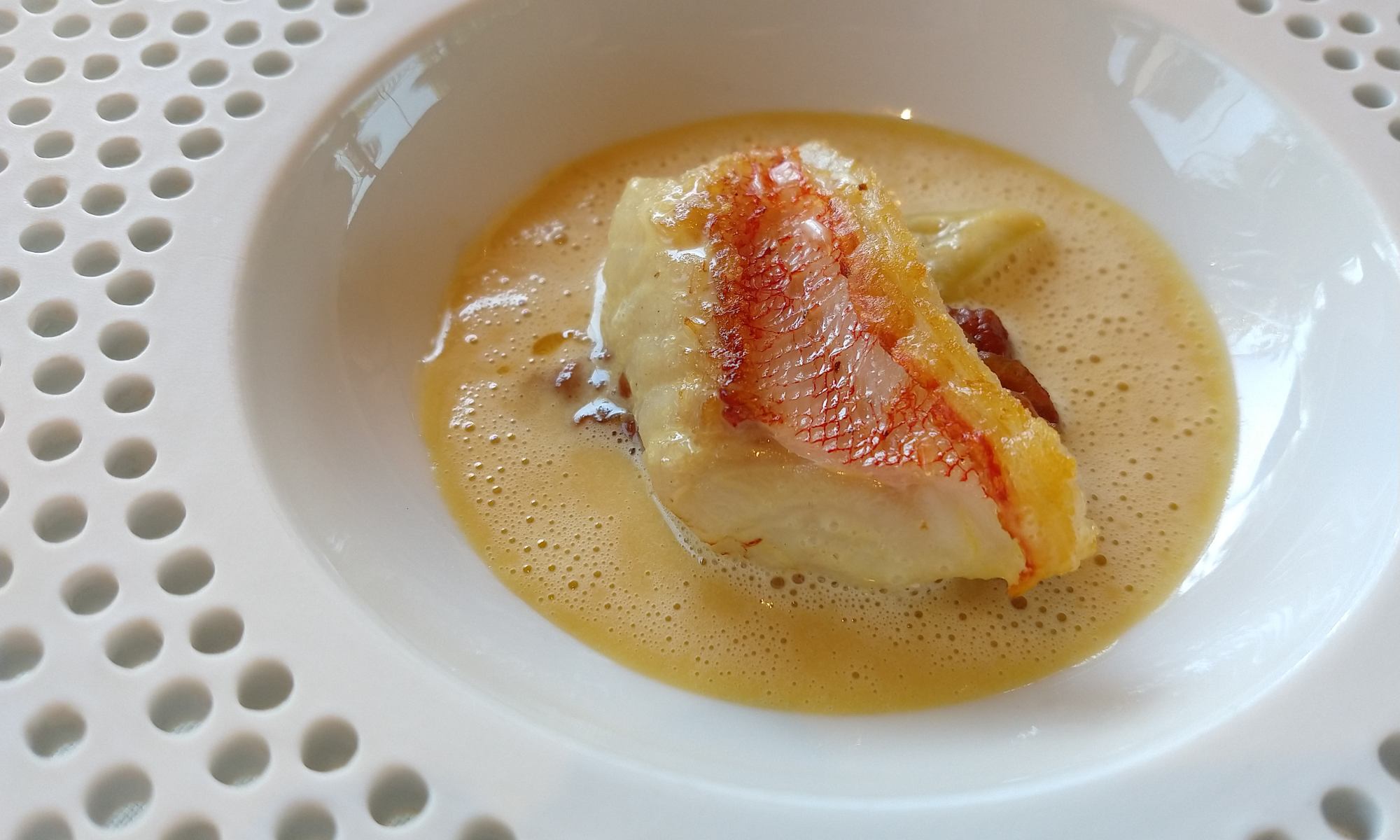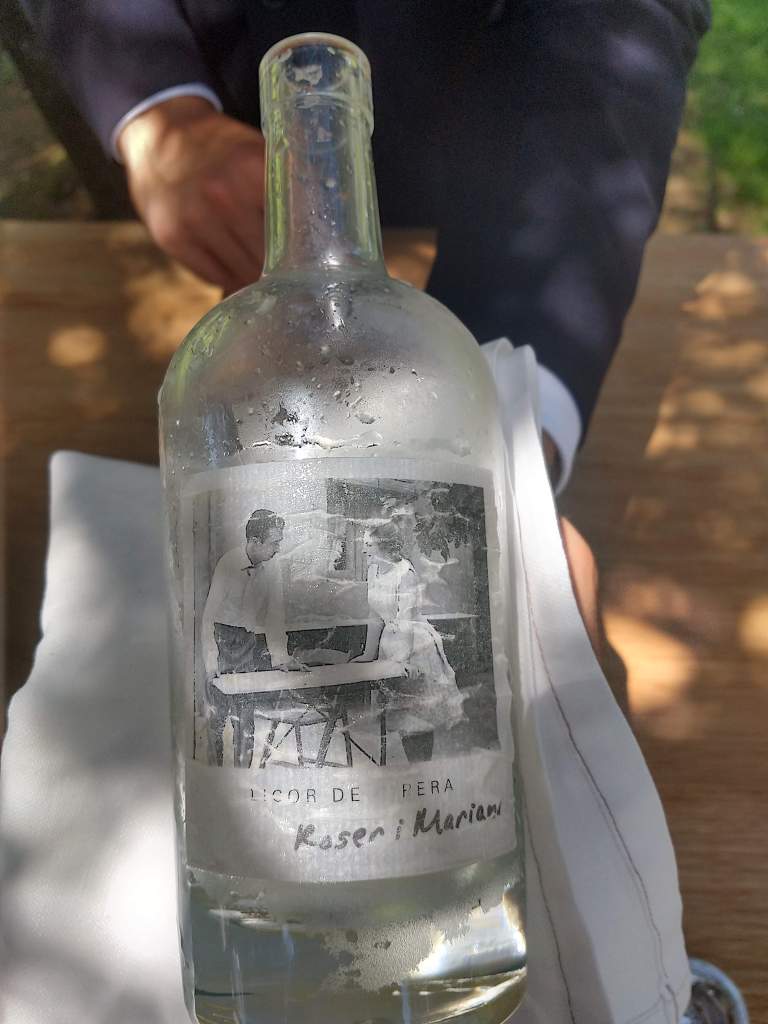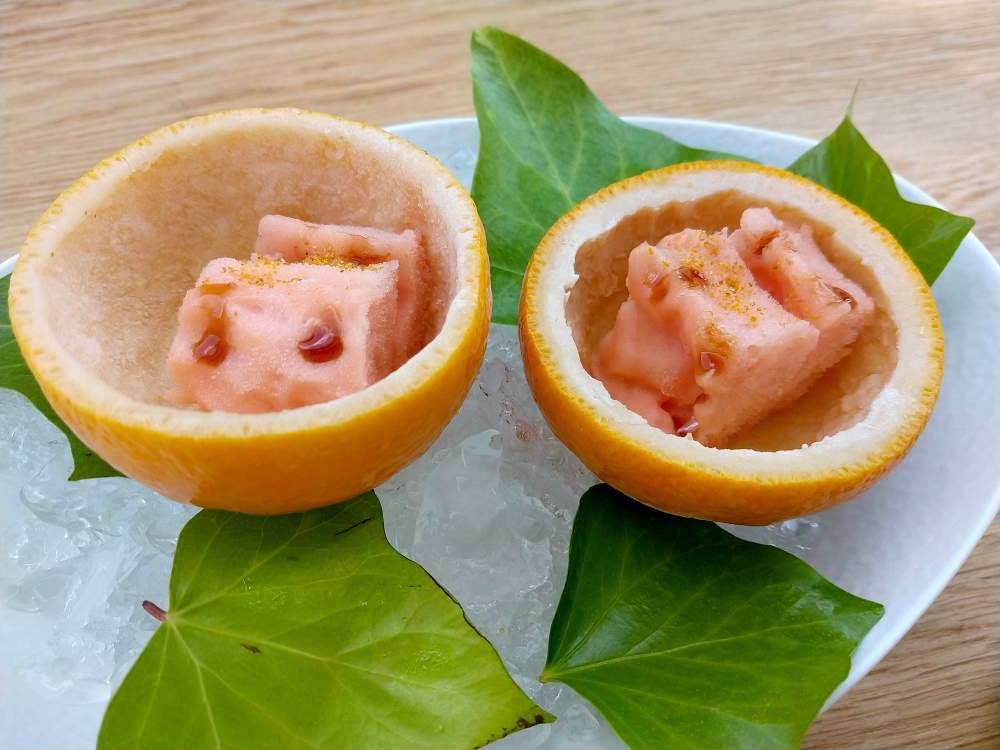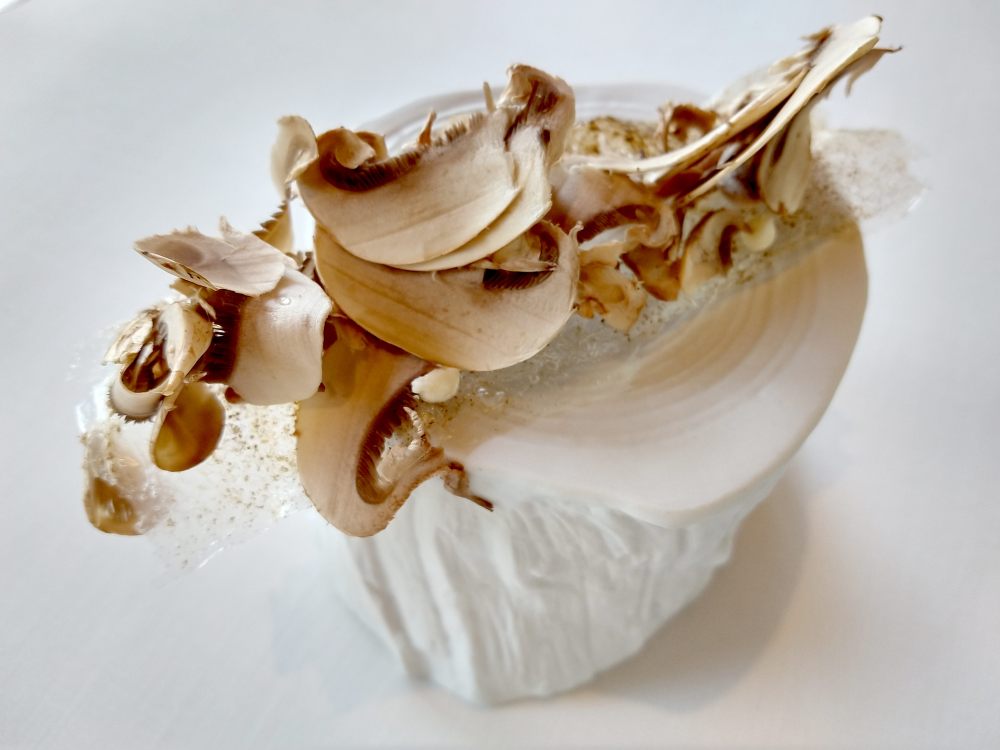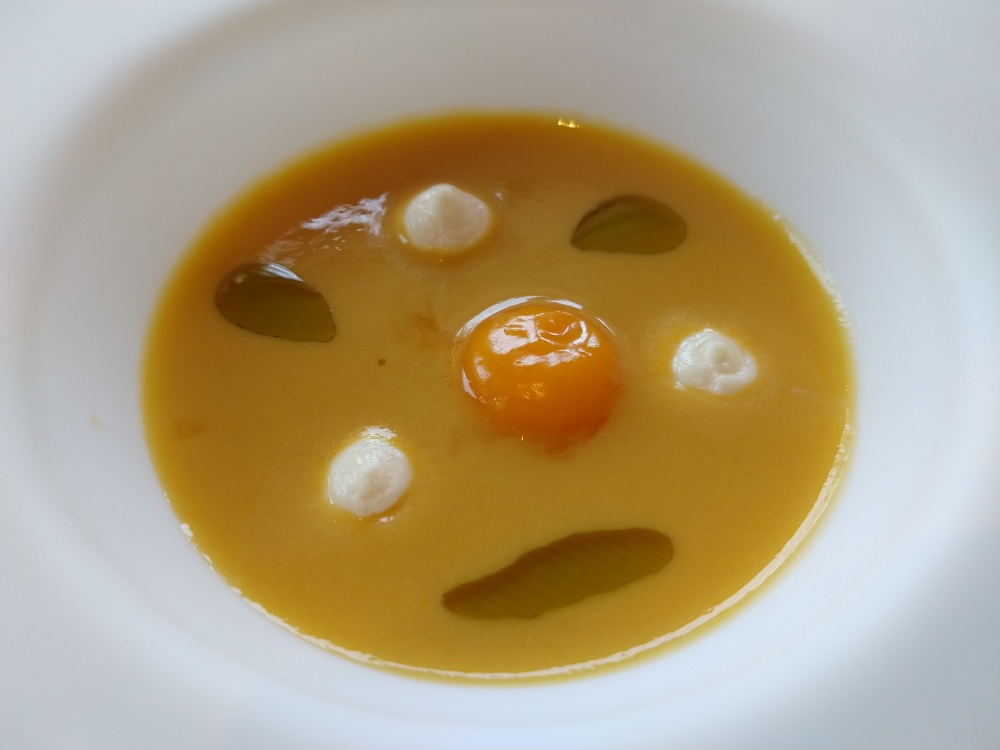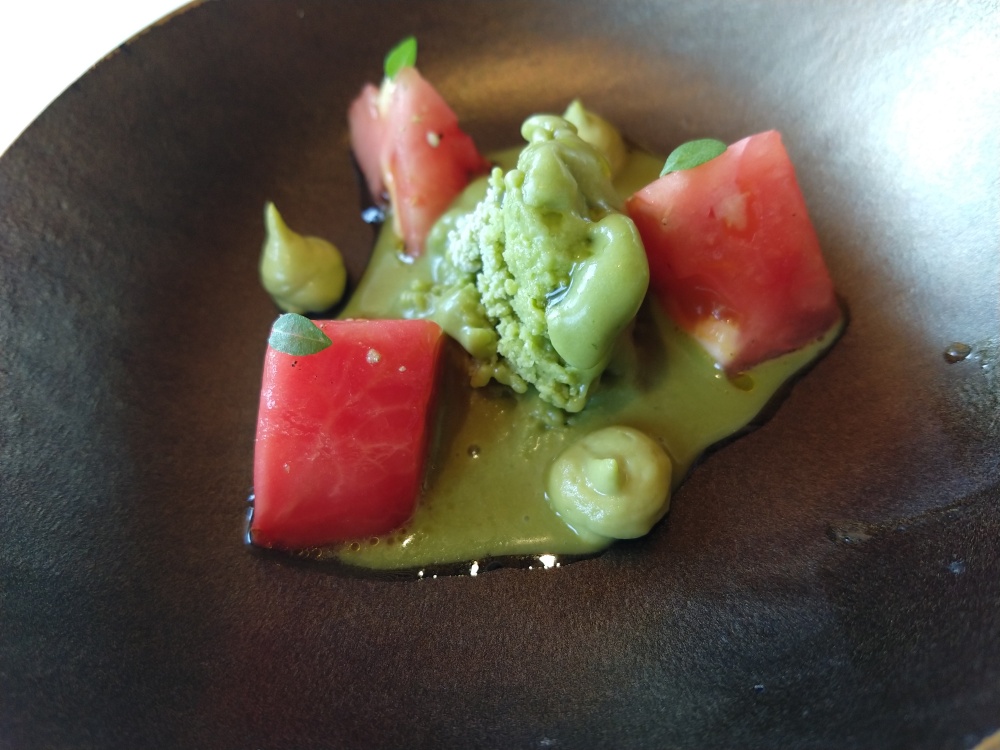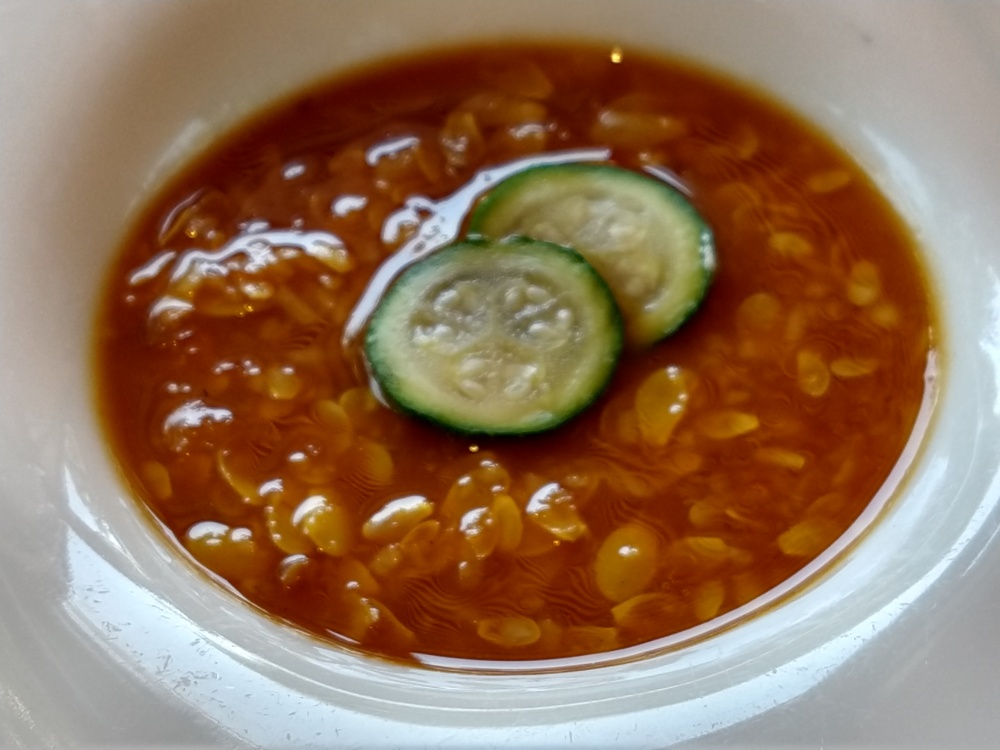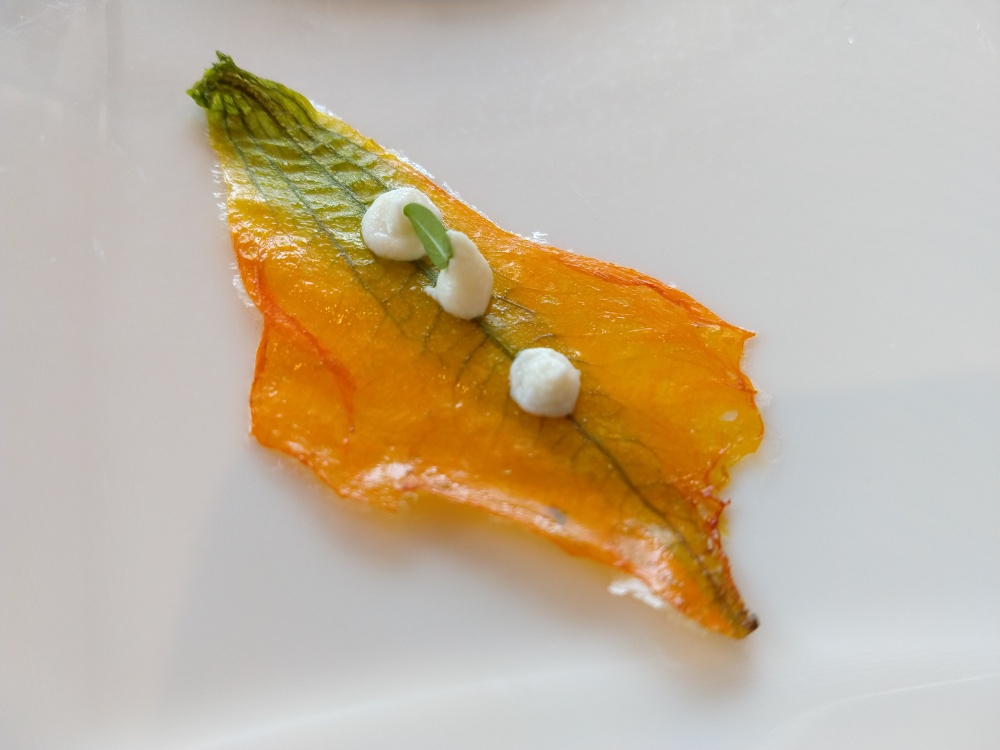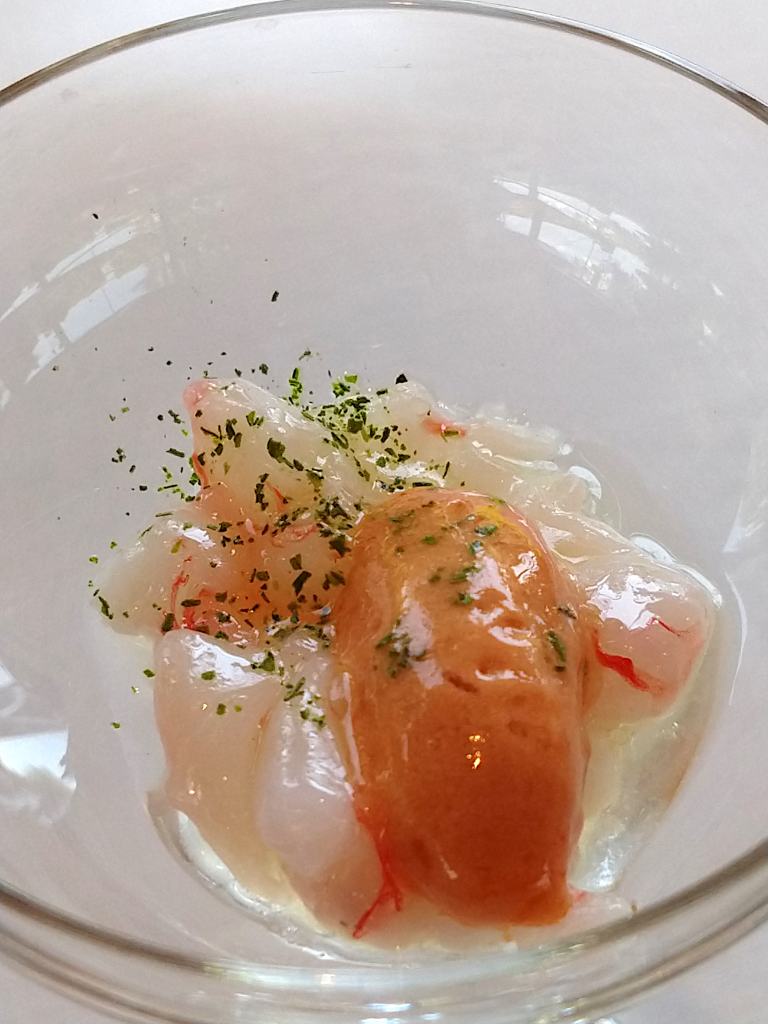

Eating in paradise among corn fields. This is La Boscana, a unique haute cuisine experience the Castanyé brothers offer in their exclusive restaurant in Bellvís (Lleida).
It had been a long time since I had eaten in a «joy» setting like this -damned coronavirus…!- and even a longer time since I went to a restaurant of this category. It was undoubtedly a culinary experience like no other, and I want to share it with you.
As a guideline, I attach the menu in order to better follow the development of the meal.

Just mention that we requested the long menu with pairing. We were pleasantly informed that almost all the wines would be white – something that for me is almost mandatory.
A fresh pear liquor immediately linked us to the surroundings of the restaurant, as well as to one of the star products of the Lleida garden. Although at the first moment I did not know it, that respect for the raw material would be the common thread that would guide us throughout the day.
VERMOUTH
The culinary experience started with an Amaro cocktail followed by a very delicate marinated anchovy (excellent texture), with its Fried spine aside (good to see that this common element in Japanese gastronomy is beginning to be seen here in Spain) and an Oyster with ajoblanco (strange but nice combination).
Product, freshness and texture made up a successful triangle. The Torelló Traditional Brut Nature 2012 (Xarelo-Macabeo-Parellada. Corpinnat, Spain -a quite new trade mark split from the denomination of cava-) accompanied us very well, although those who are acquainted with my personal preferences will know that along with the sparkling wine I would rather have opened a fine Manzanilla (a dry Sherry type of wine) and played between the two wines.
From there we went to the dining room. It was spacious, bright with a high and minimalist ceiling. «Less is more», Mies van der Rohe used to say. Here the architecture reminded me of the German Pavilion from the 1929 Universal Exhibition in Barcelona along with a touch of Japanese landscaping. The large stained glass windows embrace the dining room on three sides and allow a total view of the deeply green garden that calms the sight and the soul.
The round tables are loosely spaced and protected by organic half moon shaped screen made of steel bars and branches. They transmit a sense of spaciousness and allow room for staff to function with ease.
Once installed at our table, facing the garden, we recover from the suffocating heat experienced outside. A pair of comfortable chairs welcomed us. The table was garnished with high quality white tablecloths with a perfect touch. Top brand glassware (Riedel, Zalto, Zwiesel) on set. We drank water. It seems like a trivial detail, but really, water is wonderful when one has suffered from suffocating heat, and I am of the opinion that it should always be on the table with other drinks -and be drunk-. In this case, the anecdote is that the water (Font Vella), not only refreshed us, but it greatly enhanced the taste of the oyster that we had just eaten and that still lingered on our palates.
At our request Manzanilla was served. Specifically it was the Fernando de Castilla Manzanilla (Palomino fino. D.O. Manzanilla de Sanlúcar, Spain), which would accompany us with the next two starters.
To start with, Lardo marino (curious interpretation of a marinated fish), followed by Eel freeter (quite successful).
VEGETABLES
First still white wine: Matallonga Escorça 2017 (Chardonnay. D.O. Costers del Segre, Spain), which accompanied the following two dishes really well: Charcoal aubergine (full aroma of vegetables made over a wood fire) and Cheese mushroom cake (simple dish made with sliced raw mushrooms on a layer of cheese of infinitesimal thickness, very pleasant).

The glasses begin to line up next to each other as the dishes are passed. The staff is attentive to details, but remains invisible, pouring wine and water as the glasses go down in level.
We now turn to Corn: cream, grill and bread. Triple dish with a predominance of aromas and soft textures. What amuses me the most is the texture of the «bread» in the form of corn and the interpretation of the salad (in sorbet).
Tomato salad, infusion and barbecue: excellent tomato. What a pleasure that good garden product gives! In this case, cooked with the fat of the xuletón (steak) and accompanied by an infusion of tomato juice. A phenomenal pairing.
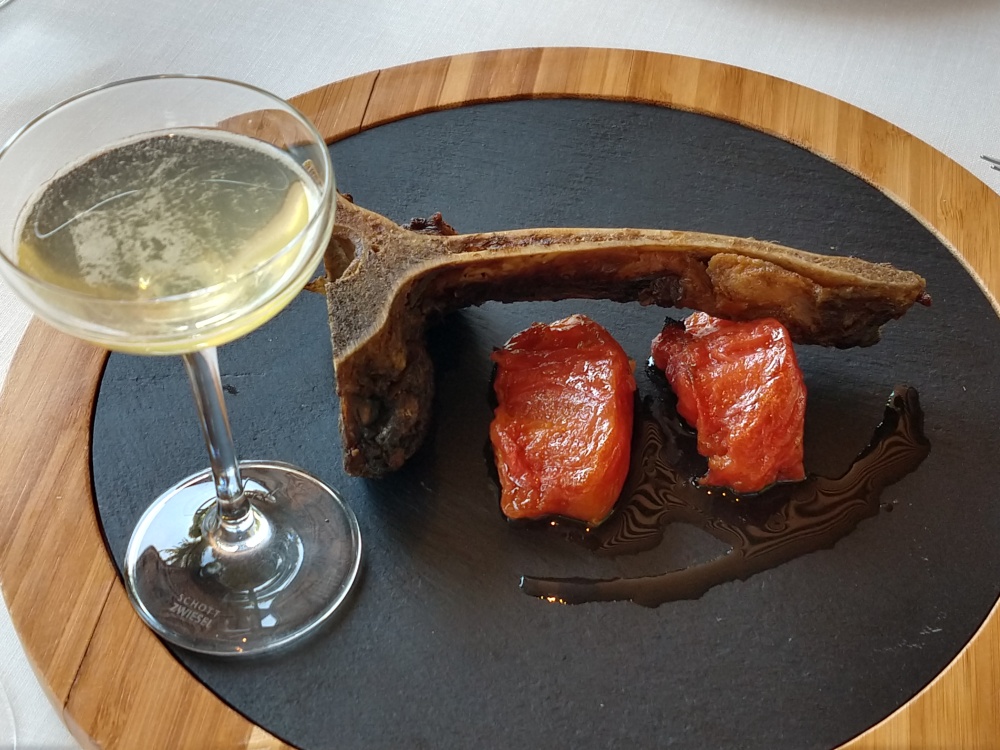
The next dish is the Courgette: risotto and its flower. Triple presentation in which the risotto (very marked by saffron) is followed by an exquisite flower and a baby courgette with what seemed to me a gelification of its content.
SEA PRODUCTS
We now go to the sea products, with a Steamed Brioche with caviar (imperial sturgeon). It acts as an entrance to the following dishes which will take center stage.
Following white wine: Oremus Mandolás Furmint 2016 (Tokaj-Hegyalja, Hungary). Very nice and full-bodied. The furmints I had tasted so far were generally quite nondescript. This one has freshness, good acidity, body and it is well balanced.
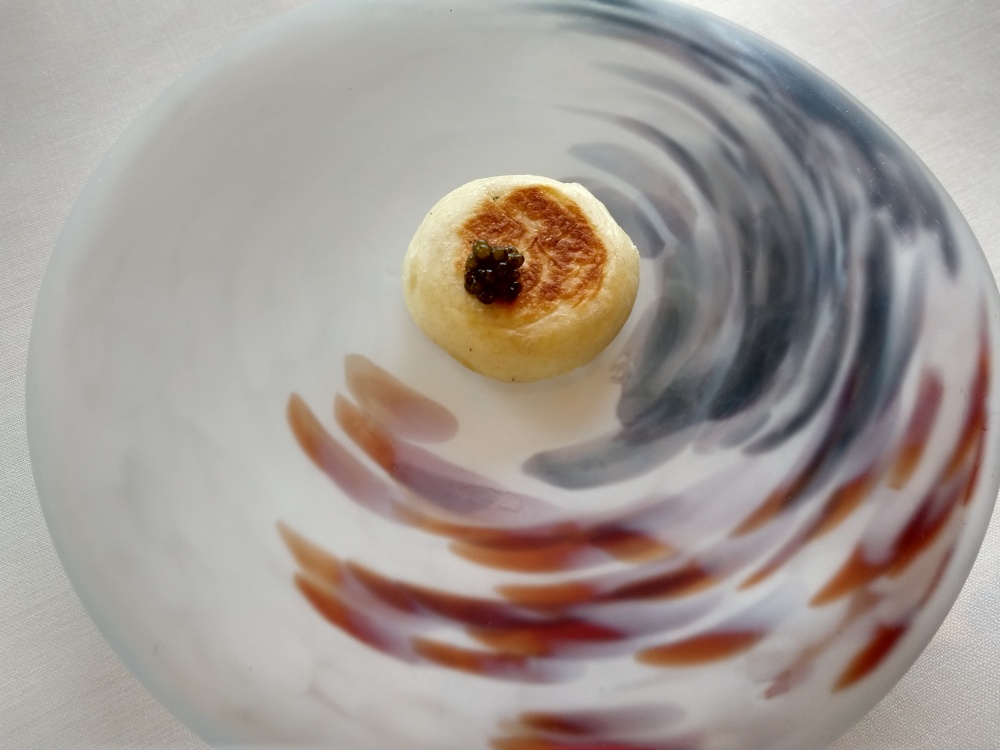
Next is a Prawn Cocktail. Head on the one hand, delicious. Tail on the other, raw and very fresh. The Furmint worked surprisingly well.
It is followed by a sea cucumber, lightly paired. Intense, smooth, very tasty. Here again, «less is more». The Furmint accompanied wonderfully.

We have reached the halfway point of the menu. We have gone through thirteen dishes, all of them with a common denominator: delicacy and lightness.
Now it was the turn of a Bonito pickled with red pepper, where the red pepper sauce moderated the intensity and rusticity of the bonito (not suitable for all audiences, but which I like a lot).

Next wine: Wagner-Stempel 2013 (Riesling, Rheinhessen, Germany). Organic and biodynamic, crispy and perfect, it will accompany the next dish with its density, intense flavour and a touch of hydrocarbons. Just wonderful.
The Sea Products part ends with King crab and dewlap, a layered delicacy – say dewlap, king crab and dried chicken skin- that provides three textures and a magical combination of flavours. It was my favourite dish on the entire menu. An awesome experience that I would have liked to last ten minutes instead of the two in which I ate it. And to top it all, the Riesling was a perfect match. Tanizaki would have had something to say about the dishes used. I do not, as I was fully enjoying the moment.

MEAT
We started the Meat section with Ham with melon, where the melon – served as juice – was accompanied by a toast of veal tartare with Iberian ham. A light and quiet preparatory entrance for the dishes to come.

Next wine: Guigal Côtes du Rhône 2016 (Grenache-Syrah. Côtes du Rhône, France). It was very elegant, polished and with smooth tannin. The only red still wine we drank paired very well with the next two-three courses.
Bone marrow, almond and caviar. In a word: delicious. Smooth, well balanced and tasty. The wine, more than accompanying, rocked the marrow. Even the caviar – with its salty character – helped to give a touch that nuanced the marrow. The Riesling paired with the dish perfectly.
Comment: it is incredible that the bone marrow, such a delicacy, such as marrow has been lost as such since the Renaissance. I would eat it daily!

We continue with Veal gizzard Robata. A nod to Japanese cuisine (robata is the short form for robatayaki, which means «grilled cuisine»). Fine, delicate and without artifice. The Guigal matched well, both for intensity and complementary textures.

TO CHOOSE
Here there was a division of roads: meat or fish. I chose fish (Grilled Gallineta – Redfish – on saffron sauce). The pairing was with Dido «La Universal» 2017 (Macabeu-Grenache-Xarel.lo. D.O. Montsant, Spain). Excellent pair.

My companion opted for meat: Suckling pig at two cooking points (too much cooked for me) which paired well with the Guigal.
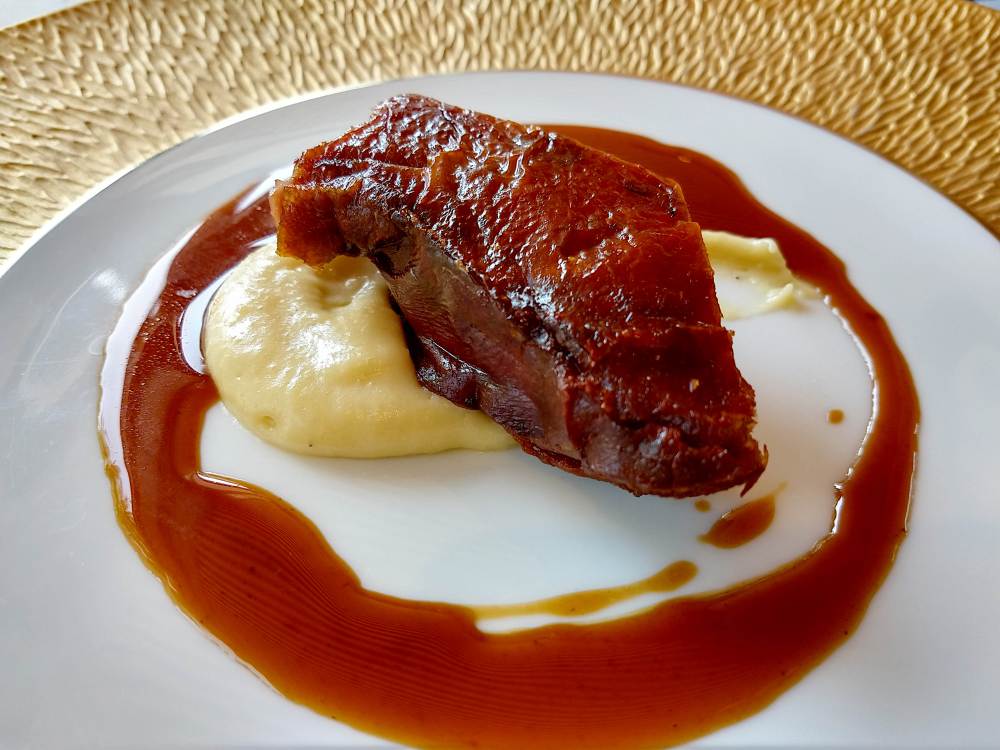
SWEETS
We had already savoured twenty plates and we were feeling very well. Everything was flowing, no dish had been out of tune and the pairings had been very successful so far, so the experience was being memorable. Now, we started with the sweet world, a world that I abandoned a long time ago and seldom catches my attention. Nevertheless, we were there to experiment, so we were going to try whatever came along.
The sommelier served us a Château Lafaurie-Peyraguey 2017 (Sémillon-Sauvignon blanc-Muscadelle. Sauternes, France). Intense while delicate. Perfect balance between acidity and sweetness (a dessert itself, of which I would have had two glasses), but now it was the turn for three more dishes.
Montsec cheese cake. Steamy on the inside and crisp on the outside, this delicacy married the Sauternes wonderfully.
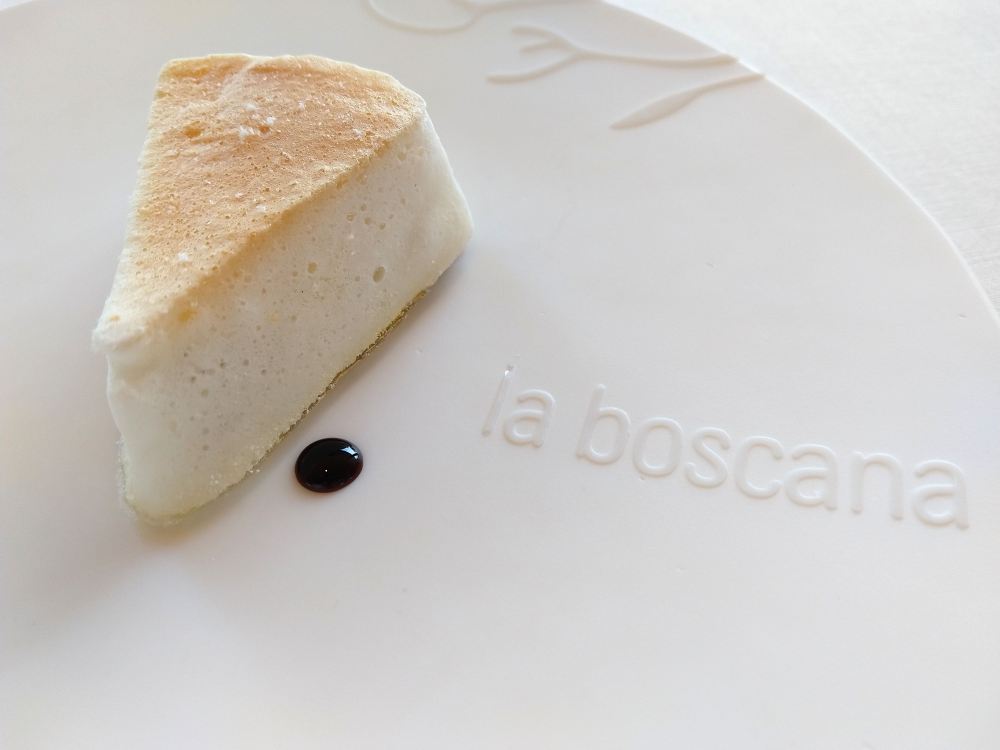
It was followed by a Fruit sorbet – refreshing and light – that cleansed the palate to get into another aromatic landscape.
Last wine service: Tintilla de Rota – Finca Moncloa- by González Byass (Tintilla de Rota. Vino de la Tierra de Cádiz, Spain). Intense on the nose and mouth, well balanced, full bodied and very flavourful. The best sweet Tintilla de Rota I have drunk so far.
Then came the Pinenut fruit sequence from Lleida, a well-resolved snack that paired very well with the Tintilla. How rare it is to have the opportunity to enjoy good sweet wines in a restaurant, even more rare if they are red!

PETIT FOUR
The Tintilla also paired very well with the last dish: Orelleta d’anís, a typical local pastry made of dried fruits and anise.
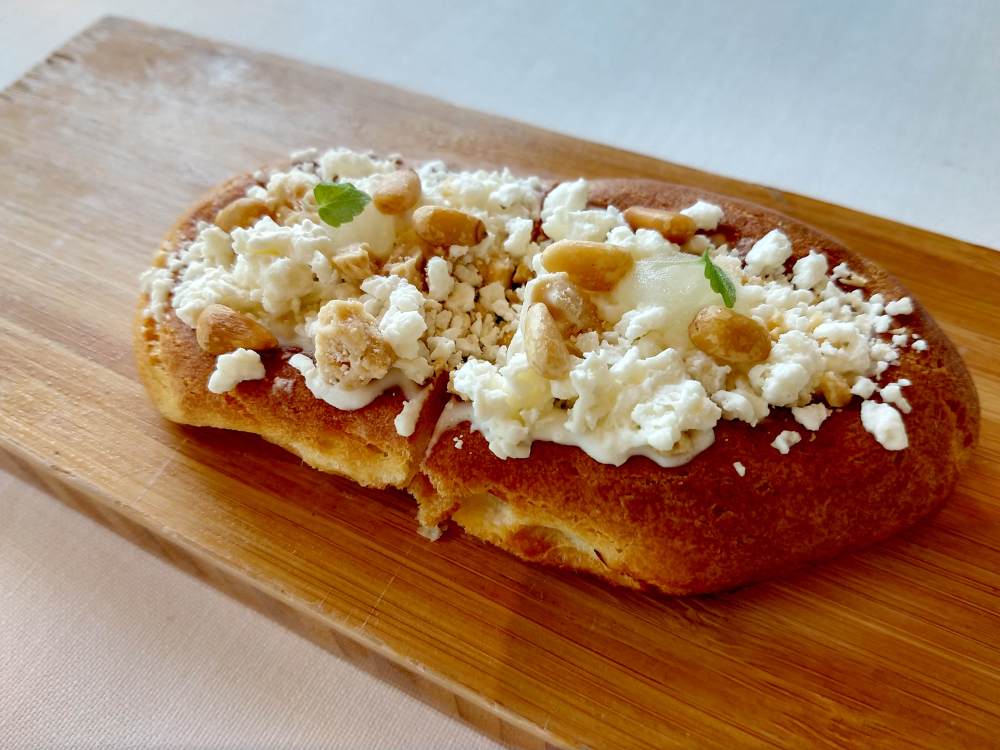
We finished our culinary experience with a very intense Arabica coffee – too much for me.
Balance, containment, lightness and raw material in the dishes and precision in the staging can be the summary of this excellent gastronomic experience.
In short: personally, I would had preferred to drink some more fortified wines, but the truth is that I have no objection to the pairings raised. They were just great!
This is how the official menu ended. We were by far the last to leave the dining room, but it did not end there. We went to the magnificent garden, where we took time to assimilate the experience we had just lived while drinking a Larios 1866 (Spanish brandy) accompanied by two Cuban cigars: Cohiba Robusto and Partagas series D nº 4.
There might also be room for some objections, but let’s leave them to professionals. I prefer to focus on the certainly positive experience I had – and that I strongly recommend you. It will not disappoint you!
In summary, it was a fantastic experience. The atmosphere was really nice. The staff was always attentive and the timing of the dishes, impeccable. The menu was excellent and light, and the pairing with the wines, exceptional. I will undoubtedly come back.
Cheers!

